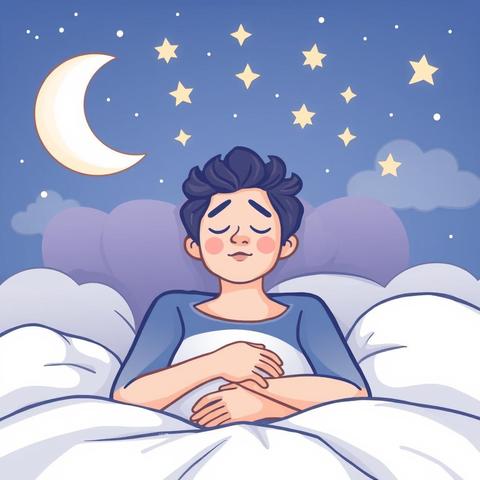Last night, I dreamt I was drowning in a sea of paperwork, each document a looming deadline. I woke up feeling anxious, the pressure of the day still clinging to me. This isn’t an uncommon experience; many of us wake from dreams feeling confused, unsettled, or even exhilarated. But what if our dreams, those nightly voyages into the subconscious, hold the key to understanding our mental health and improving our sleep? This article explores the profound connection between sleep, dreams, and mental wellbeing, providing insights into dream interpretation and practical strategies for a more restful and meaningful life.
The Intertwined Worlds of Sleep, Dreams, and Mental Health
Our mental and emotional states are intricately linked to the quality of our sleep. Chronic sleep deprivation can exacerbate anxiety, depression, and other mental health challenges. Conversely, addressing mental health concerns can significantly improve sleep quality. Dreams, the often-enigmatic narratives playing out during REM sleep, offer a unique window into our inner world, reflecting our thoughts, feelings, and unresolved issues.
The Neuroscience of Dreaming and Mental Well-being
Neuroscientific research reveals that dreaming plays a crucial role in memory consolidation, emotional processing, and problem-solving. During REM sleep, the brain actively processes information acquired throughout the day, consolidating memories and integrating emotional experiences. This process can significantly impact our mental state upon waking. For instance, a dream resolving a conflict might lead to feelings of peace and clarity, while a disturbing dream might leave us feeling anxious or unsettled.
- Memory Consolidation: Dreams help solidify memories, transferring them from short-term to long-term storage. This is particularly important for emotional memories, which are deeply ingrained in our subconscious.
- Emotional Regulation: Dreams provide a safe space to process emotions, particularly those we may struggle to confront during waking hours. They allow us to explore anxieties, fears, and unresolved conflicts in a symbolic and non-threatening way.
- Problem-Solving: Dreams can facilitate creative problem-solving. By detaching from conscious limitations, the subconscious mind can explore novel solutions and perspectives. A “eureka moment” often arises after a period of rest and dream activity.
Decoding Your Dreams: A Guide to Dream Interpretation

Dream interpretation is a complex field, and there’s no one-size-fits-all approach. However, understanding common dream symbols and themes can offer valuable insights into your inner world. Let’s explore some key aspects of dream analysis.
The Hidden Meanings Behind Common Dream Symbols
Many dream symbols hold universal significance across cultures and time periods. However, personal associations and contexts are crucial for accurate interpretation. Consider the following:
- Sleep Aids and Supplements: Navigating the World of Better Sleep
- Technology and Sleep: How Our Devices Impact Our Dreams and Dream Therapy
- Stress and Sleep: Unlocking the Secrets Your Dreams Reveal
- The Science of Sleep: Unlocking the Mysteries of Your Dreams
- Sleep in Different Age Groups: A Comprehensive Guide to Understanding Your Restful Needs
- Flying: Often signifies feelings of freedom, empowerment, and transcendence. However, a dream about struggling to fly might represent feelings of being overwhelmed or lacking control.
- Falling: Typically associated with feelings of loss of control, insecurity, or fear of failure. The context of the fall—the height, the landing—can provide further clues.
- Water: Represents emotions, subconscious feelings, and the flow of life. Calm, clear water suggests peace and tranquility, while turbulent water might symbolize emotional turmoil.
- Teeth Falling Out: Often symbolizes feelings of anxiety, powerlessness, or a loss of control in a particular area of life. This is frequently linked to anxiety over appearance or self-esteem.
- Being Chased: Often reflects feelings of being pursued by anxieties, fears, or unmet responsibilities. The identity of the chaser offers insight into the nature of the anxiety.
Common Variations and Themes in Dreams Related to Mental Health
Dreams can directly reflect mental health concerns. For instance:
- Recurring Nightmares: May indicate unresolved trauma, anxieties, or persistent stressors. The repetition itself underscores the need for processing and addressing the underlying issue.
- Dreams of Death or Dying: While often frightening, these dreams aren’t necessarily premonitions. They can symbolize significant transitions, endings, or the need for letting go of something that is no longer serving you. The emotional response within the dream is crucial for interpretation. Did you feel relief? Fear? Acceptance?
- Dreams of Being Lost or Trapped: Often symbolize feelings of confusion, disorientation, or being overwhelmed by life’s challenges. The environment in the dream – a dark forest, a maze – can provide additional clues.
- Dreams Involving Violence or Aggression: Might reflect suppressed anger, frustration, or unresolved conflict. The target of the aggression is as important as the act itself.
The Interpretation and Deeper Message of Dreams
The ultimate goal of dream interpretation isn’t merely to decipher symbols but to understand the underlying emotional and psychological messages. Dreams often serve as a guide to self-discovery, prompting reflection and self-awareness. Asking yourself these questions can be helpful:
- What emotions did the dream evoke?
- What recurring themes or symbols appear?
- How does this dream connect to my current life circumstances?
- What unresolved issues might this dream be highlighting?
- What message is my subconscious trying to communicate?
One client, Sarah, repeatedly dreamt of being trapped in a dark, claustrophobic room. Through exploration, we discovered her dream reflected her feelings of being overwhelmed by work pressures and a lack of control over her life. By identifying the underlying issue, she was able to develop coping mechanisms and reclaim a sense of agency.
Practical Advice for Dreamers

Turning dreams into a tool for self-improvement requires conscious effort. Here’s how you can make the most of your nocturnal journeys:
- Keep a Dream Journal: Write down your dreams immediately upon waking, including all details you can recall—even fragments or seemingly insignificant elements.
- Reflect on Your Dreams: Spend time pondering your dreams throughout the day, considering their potential significance and emotional impact.
- Practice Mindfulness: Mindfulness techniques can improve sleep quality and enhance your ability to recall and interpret your dreams. Meditation can reduce racing thoughts and create a more peaceful state before sleep.
- Seek Professional Guidance: If you are struggling to interpret your dreams or if they are causing significant distress, consider seeking professional help from a dream therapist or mental health professional.
Improving Sleep Hygiene for Enhanced Mental Well-being
Beyond dream interpretation, improving your sleep hygiene is paramount for mental health. Adopting healthy sleep habits can significantly reduce anxiety, improve mood, and boost cognitive function.
- Establish a Consistent Sleep Schedule: Go to bed and wake up around the same time each day, even on weekends, to regulate your body’s natural sleep-wake cycle.
- Create a Relaxing Bedtime Routine: Engage in calming activities before bed, such as reading, taking a warm bath, or listening to soothing music. Avoid screens at least an hour before bedtime.
- Optimize Your Sleep Environment: Ensure your bedroom is dark, quiet, and cool. A comfortable mattress and pillows are also essential.
- Get Regular Exercise: Physical activity can improve sleep quality, but avoid intense workouts close to bedtime.
- Limit Caffeine and Alcohol Before Bed: These substances can disrupt sleep patterns and lead to poor quality sleep.
- Manage Stress: Practice stress-reduction techniques like yoga, meditation, or deep breathing exercises to promote relaxation and improve sleep.
The Role of Dream Therapy in Fostering Personal Growth
Dream therapy provides a powerful framework for understanding and utilizing dreams as a pathway to personal growth. A skilled dream therapist can guide you in exploring the symbolism of your dreams, connecting them to your waking life, and developing strategies for resolving underlying emotional issues.
Dream Therapy Techniques
Dream therapy often utilizes various techniques including:
- Dream Amplification: Exploring the details and associations of a dream in greater depth.
- Dream Weaving: Creating a new dream narrative that resolves a conflict or incorporates positive changes.
- Active Imagination: Engaging in dialogue with dream characters or situations to gain deeper insight.
- Gestalt Therapy: Focusing on the emotional experience within the dream and its connection to the present moment.
By working with a therapist, you gain insights that can lead to increased self-awareness, better emotional regulation, and improved overall mental wellbeing.
Conclusion: Embrace the Nightly Journey
Your dreams aren’t just random bursts of imagery; they’re a rich tapestry woven from your thoughts, emotions, and experiences. By understanding their significance and actively engaging with your dreams, you unlock a path towards better sleep, enhanced mental health, and profound self-discovery. At Dream Therapy Now, we specialize in helping individuals navigate the complexities of their dreams and improve their sleep quality through expert analysis, sleep science, and therapeutic practices. Let us guide you on your path to clarity and transformation. Contact us today at info@dreamtherapynow.com or visit us at 143 Horizon Dr, Bedford, NH 03110 to schedule a consultation. Your journey to a more fulfilling and restful life begins now.
Dive into our blog to discover a wealth of content that will illuminate the significance of your nocturnal adventures and guide you through the labyrinth of dream symbolism. Impeccable Dream hopes this guide was helpful! If you want to see other blog posts about Sleep Hygiene Practices, here are some that may be of interest to you.